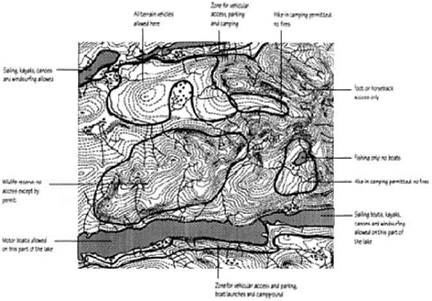As already mentioned, zoning is one of the major ways in which to resolve conflicts between different users and between users and the landscape. The inventory and analysis described above may simplify the job. Zoning identifies what is acceptable where, although it can include more than just physical factors. Aesthetic considerations and expectations of the experience to be enjoyed can also be built into the exercise. Zones can be based on any convenient and comprehensible unit that helps to manage activities and the landscape in compatible ways.
Following the first coarse sieve of allocating activities to appropriate areas, more refined zones can set limits on what, how much and when activities can take place. Different scales might be employed, from the whole land ownership unit down to subzones within broad categories. Zones might be based on areas: for example a large zone for hiking might be subdivided into zones in which camping is permitted. The camping zone might be further subzoned into an area for tents and one for trailer caravans, and so on.
Zones can also be based on linear routes. Different trail systems might be subzoned, for example, by mode of use—horse, foot, cycle—or by degree of difficulty for people with various disabilities.
Zoning in time is another approach. This might be long term: for example, lease of an area for use by a particular interest group for a set period. Seasonal zoning is easy to administer, especially when particular weather is necessary, such as snowy conditions for skiing. Weekly or daily use can spread out and lessen the impacts of activities; examples are booking a permit to go fishing or for access into back country for a particular time duration. Once again, any convenient time interval can be adopted that meets the
management objective.
|
Examples of spatial zoning of use applied to a landscape. |
The idea of zoning to meet aesthetic and aspirational needs is one that has been developed in particular by the US Forest Service, and is now used in various forms elsewhere. This is called the Recreation Opportunity Spectrum or ROS. While designed for large scales of landscape, the general principles can be adapted for the smaller areas more common in Britain and parts of Europe.


